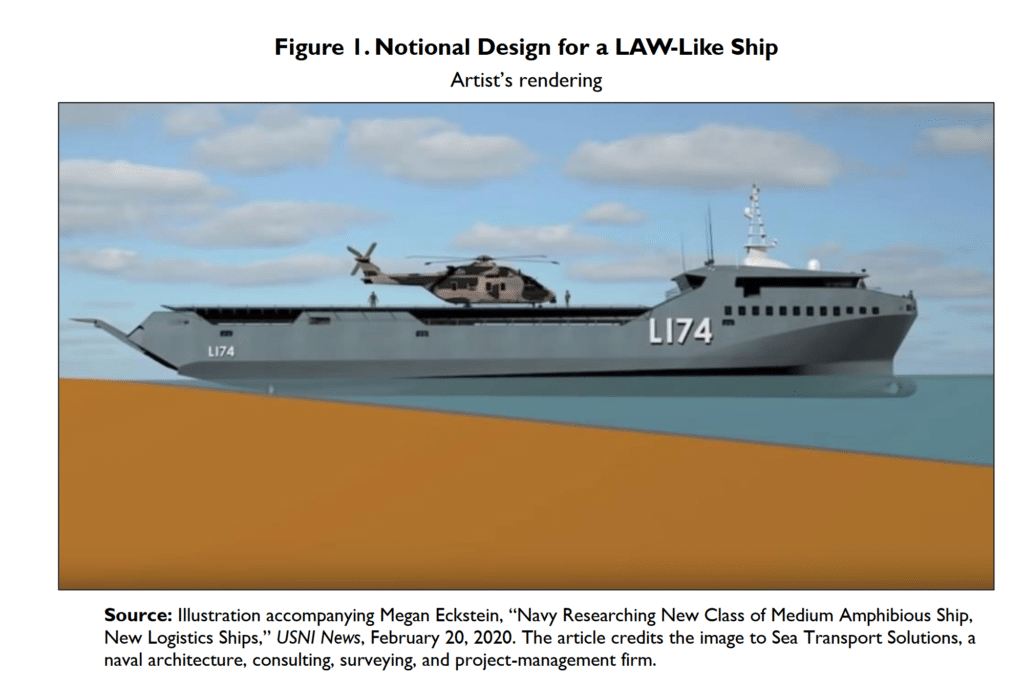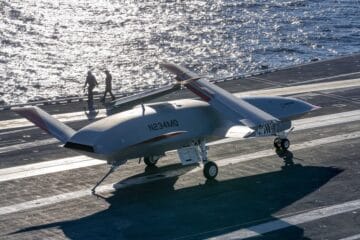Naval News spoke with the U.S. Army, Japan, operators of the Army’s LCU ships about their views, recommendations, insights, and opinions on the U.S. Navy’s LAW when compared with the U.S. Army’s LCU.
The U.S. Navy’s Light Amphibious Warship (LAW) is meant to transport the U.S. Marine Littoral Regiment (MLR) to conduct amphibious landings, depositing vehicles directly onto the island beaches for establishing Expeditionary Advanced Basing Operations (EABO) and Stand-in Forces to conduct sea denial and MLR Anti-Shipping/Anti-Access operations.
Naval News sent an email inquiry to U.S. Army, Japan, in late January 2022 and received a reply from the Army’s 10th Support Group Public Affairs, Major Richard Barker. Major Barker said that the answers for the Naval News Questionnaire were jointly prepared by CW2 William T Thompson, Vessel Master of LCU 2009 Calaboza and CW2 Sean K Meenan, Vessel Master of LCU 2020 Fort McHenry.

Naval News: It is said that the U.S. Army has more boats than the U.S. Navy. Can you please explain the role of the Army LCUs and amphibious boats and why the U.S. Army can’t fulfill the LAW mission concept in the INDO-PACOM region or amphibious assault or transport?
10th Support Group: The role of the Army LCU is for logistics over-the-shore capabilities and to work in and around degraded ports. I think that the Army could contribute to the transport portion of the LAW mission in some circumstances. The strength of the Joint Force comes from our flexibility. There may be times when the Marines need to move large amounts of equipment and the Army is available to assist. The Army LCU can transport 350 short tons of cargo over a range of 6,500 miles at 12 knots without refueling. While this requires joint communications with the branches, and the ability for Army vessels to communicate with Navy vessels on a tactical level, we are currently working on [a] new development in Bridge Communication Systems to help better integrate with our fellow services.
Naval News: Can you please explain the role of constant LCU patrols versus moving prepositioned armored vehicle stocks in the INDO-PACOM region and if constant LCU patrols are needed more than ship transports to move prepositioned armored vehicle stocks?
10th Support Group: The LCU is not a maneuver asset; it is a logistical asset for moving large quantities of supplies and materials to include equipment. Also, these vessels are flat-bottomed which permits access and maneuvering ability in all deep and shallow water areas of operation. That said, they are at the mercy of the elements especially in the INDO-PACOM area; therefore, are not patrol-type vessels and are not equipped to do so. The Army LCU is better equipped to move prepositioned stocks of vehicles and supplies, but relies heavily on the weather to cooperate; these vessels can handle 10ft waves on the bow and stern, but only 5ft waves on the beam.
Naval News: Why does the U.S. Army operate large LCUs and not hovercrafts, catamarans, barges, vehicle ferries, or Landing Ship Tanks for its armored vehicles?
10th Support Group: All of the watercraft mentioned were once in the Army’s inventory but were either divested, sold, or transferred to the Navy. The HSV’s are catamarans that were transferred to the Navy. The Army does still operate several other classes of Vessel’s, to include the LCM [Landing Craft Medium] Small Tugboat, LSV’s [Logistic Support Vessel] and the Causeway System, with another Vessel, the MSV-Light in current development. These vessels best support the Army Watercraft’s mission of providing logistical and operational support to Commands in a variety of environments and conditions.
Naval News: What advice, suggestions, recommendations, and guidance would you as the U.S. Army operating LCUs give to the U.S. Navy and the U.S. Marines regarding the LAW concept, the LAW ship design, the LAW’s size and performance, the LAW’s armament, and vehicle landing ships in general?
10th Support Group: Based on my experience in the INDO-PACOM region, the “LAW” concept is very fitting. It is meant to be a hybrid of a patrol/warship and also conduct logistical operations. I believe that it would be a valuable asset for the Navy to conduct amphibious operations as well as have the armament to defend itself. The Army LCU’s and LSV’s are logistical haulers, not maneuver assets. From what I can tell looking at the model drawings, the overall LAW design is good; however, with a landing pad it will limit what the “LAW” can carry as far as containers and may be limited to vehicles. I would suggest that there are two different designs with different mission sets if that is the case.

Photo: Naval News at Sea-Air-Space Expo
Naval News: Based on U.S. Army LCU experience, what and how can the LAW design be improved?
10th Support Group: From the drawings and models, there are two very different concepts, one with a stern ramp [Sea Transport Solutions] and the other with the LSV design “Kuroda class” enabling the nose of the vessel to be lifted and a ramp to unload vehicles along with other cargo [Austal’s design]. I think that it is best for the vessel master to be able to see the payload while maneuvering the vessel to ensure proper placement on a beachhead or port ramp. It is a lot easier to control the vessel moving forward than while backing in.

Naval News: How easy or difficult is it to operate a LCU called on constant duty and please explain some of the logistics, fuel, crew comforts, challenges, and maintenance involved.
10th Support Group: With my LCU experience within the INDO-PACOM area, I have found that operating continuously can be done relatively easily. For instance, we can carry enough fuel to operate months at a time without refueling. While in port, we only require basic husbandry for trash and food; however, we require monthly subsistence resupply. In terms of personal space, the crew has small staterooms with double bunks.

Naval News: What advice and suggestions can the U.S. Army give to the U.S. Navy and USMC about operating and sailing in the INDO-PACOM region as an LCU or LAW?
10th Support Group: The weather is highly volatile in this region; that is a big challenge for flat-bottom landing craft. I can say from experience that 12ft waves in an LCU is not fun and is really hard on the crew. But these vessels give us an advantage to land on small beachheads and unimproved ports with relative ease. I see these vessels as a very important asset when conducting forward and resupply operations with little to no infrastructure. For the size of the Vessel, we are able to get into ports, unimproved ports, and areas that similarly-sized Vessels would be otherwise unable to reach.
Naval News: Is it really that easy to drive amphibious ships onto beaches and shores to unload armored vehicles, or are smaller landing crafts, boats, and hovercrafts preferred?
10th Support Group: As with any type of beach landing you have to know what the bottom looks like; this can be done with surveys, maps, and other types of intel. I think it all depends on the scope of equipment that is being transported. Of course, smaller landing craft may be easier to get into small openings where coral reefs are present, or where a smaller window of beach is available. In addition to the physical features and obstacles of the beach, another consideration is tides, and sea state. You have to be able to ensure that you can unload or load the cargo, and still be able to retract off of the beach. If the tide goes out, or [there] is a big tidal change, you run the risk of being stuck. Utilizing a stern anchor can be an asset to help with this, but you still must pay attention to the elements. [More information about U.S. Navy ship-to-shore connectors can be found here.]
Naval News: Does the U.S. Army ever foresee embarking on LAWs for joint-Army/Marine deployments with Army M1A2 SEPv3/4 Abrams tanks, M2A3 Bradleys, AMPVs, Strykers, Army soldiers, and other heavy Army armor?
10th Support Group: This is possible. The strength of the Joint Force comes from our flexibility. There may be times when the Marines need to move large amounts of equipment and the Army can assist. At other times, the Army may need to surge and the LAWs can assist. In terms of LCU capability, the Army LCU can carry up to five M1 Abrams tanks, and all the other vehicles listed above; however, they are not meant for troop transport. Here in the INDO-PACOM region, we have supported several Marine organizations by transporting their equipment and, in some cases, limited amounts of soldiers. I believe that we can support any operation that needs logistical heavy haulers given the right time frame and weather. The LCU platform provides an almost limitless variation of configurations to support a wide variety of operations.

Naval News: How easy, laborious, dangerous, and safe is it to conduct operations on a LCU regarding helicopter transport, CSAR, RHIB, firing HIMARS missiles from the deck, armor roll-on and roll-off-loading, and sailing with all those armored assets aboard?
10th Support Group: With any operation comes the element of danger, loading and unloading armored equipment is somewhat laborious, but no more than other equipment. We have done several helicopter operations with good results working with both the Air Force and Marines. We provide a platform for VBSS training and RHIB operations. We have had nothing but positive feedback from the Marine units that we have supported in this aspect.
Naval News: What does every U.S. Army LCU captain and crew desire from the U.S. Navy and U.S. Marines when operating LCUs in INDO-PACOM (e.g.: warship escorts)? What would the U.S. Army expect from the U.S. Navy and U.S. Marines when they have their LAWs?
10th Support Group: In certain situations, a warship escort may be warranted while sailing in contested waters. The biggest issue that we have is the inability to communicate with Navy vessels on a non-civilian maritime frequency. These vessels are built for commercial operations and all of the communications equipment is set up for that purpose. We are currently working on new development in Bridge Communication Systems to help better integrate with our fellow services.






